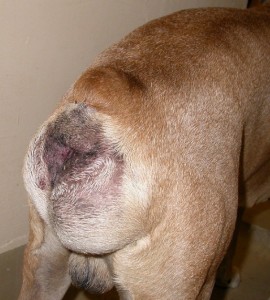News
Perineal Rupture
by admin on August 31st, 2018
Category: News, Tags:
What is a perineal rupture?
A perineal rupture (sometimes called a perineal hernia) is a weakness or separation of the muscles of the pelvic diaphragm. The pelvic diaphragm is formed from a group of muscles that are situated around the rectum and form the caudal (back) wall of the abdominal cavity.
A perineal rupture is an abnormal hole in this diaphragm or sheet of muscles that allows fat or organs from the abdominal cavity to bulge into the area surrounding the anus (the perineum).
What are the clinical signs?
Clinical signs can include:
- Perineal swelling – this can fluctuate in size
- Perineal bruising
- Pain/discomfort associated with the swelling
- Pain or discomfort when passing of faeces
- Constipation
- Urine retention – an inability to empty the bladder properly
- Acute illness due to obstruction of urine flow from the bladder
- Generalised malaise
What animals are affected?
The condition predominantly affects middle aged to older male dogs, particularly entire (uncastrated) males. However, younger male dogs, female dogs and cats can also be affected.
What are the causes?
There is a strong association between perineal rupture and the male hormone levels in middle aged to older entire male dogs. Any disease process that affects the levels of male hormones can therefore predispose to perineal rupture.
In addition, any condition that results in straining or increased intra-abdominal pressure can result in failure of the pelvic diaphragm muscles.
Risk factors for perineal rupture include:
- Entire (uncastrated) male status
- Disease of the testicles (e.g. tumours)
- Disease of the prostate gland, which is found near the neck of the bladder in male animals (e.g. benign enlargement, abscess, cysts, tumours)
- Straining due to abdominal disease (e.g. colitis [inflammation of the large intestine])
- Pregnancy (due to increased abdominal pressure)
What does investigation involve?
In order to maximise the chance of successful treatment of the rupture, it is important to identify risk factors that are present in the patient and treat these at the same time as treating the rupture. Each investigation is likely to be tailored specifically to the patient, although typically this may include the following:
- Rectal examination (which may require sedation or general anaesthesia) – this will include assessment of the side opposite to the obvious rupture
- Blood tests
- Urine analysis
- Ultrasound scan of the abdomen and possibly of the hernia
- Prostate gland investigation/biopsy
- Examination of the testicles
- Chest X-rays in some cases
Cases with displacement of the bladder can present as emergencies and require urgent stabilisation prior to investigation and treatment.
What treatment options are available?
Most cases will require repair of the rupture and this is combined with castration in entire males to reduce the risk of failure. Those cases with other disease processes that have contributed to the development of the rupture will need to receive treatment for that underlying problem, prior to or at the same time as repair of the rupture.
Some ruptures are repaired using the muscles that are present within the pelvic diaphragm, although many require movement of additional muscle into the area in order to close the rupture. In some severe cases, mobilisation of a muscle from a hind leg or a synthetic mesh may be required to complete the closure.
Further support for the repair can be given by fixing the bladder and colon (large intestine) into the abdomen but this is not necessary in all cases.
What is the prognosis (outlook)?
Over 90% of uncomplicated cases receiving rupture repair and castration resolve following the surgery.
In experienced hands, complications following surgery are infrequent, and animals usually stay in the hospital for a few days to ensure they are comfortable and passing faeces easily.
Despite careful selection of the technique used and meticulous care, complications can occur in a minority of cases and these include:
- Recurrence of the rupture – stool softeners may be advised long term to reduce the straining during defaecation and therefore protect the repair
- Rupture of the other side
- Infection (the surgical site is in the perineal region, near to the anus which is a source of bacteria)
- Faecal incontinence – this is uncommon and usually temporary


